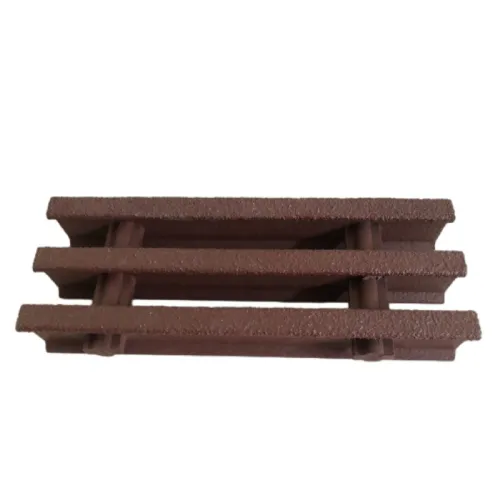loading...
- No. 9, Xingyuan South Street, Dongwaihuan Road, Zaoqiang County, Hengshui, Hebei, China
- admin@zjcomposites.com
- +86 15097380338
- Welcome to visit our website!
Designing Effective Floor Drain Grates for Optimal Drainage and Debris Prevention
Understanding Floor Drain Grating Importance, Types, and Maintenance
Floor drain grating is an essential component in modern plumbing systems, allowing for the effective drainage of water and preventing the accumulation of unwanted liquids in various settings. Whether it is in residential bathrooms, commercial kitchens, or industrial facilities, floor drains play a crucial role in maintaining hygiene and safety. This article will delve into the importance of floor drain grating, the different types available, and maintenance tips to ensure their efficiency.
Importance of Floor Drain Grating
Floor drain grating serves several essential functions. Primarily, it facilitates the efficient flow of water away from areas prone to pooling, thus preventing slips and falls. In commercial settings, this is particularly vital, as wet floors can lead to accidents that may result in injuries and legal liabilities.
Moreover, well-designed grates help keep debris and larger particles from entering the plumbing system. By screening out leaves, dirt, and other materials, drain grating helps prevent clogs, which can lead to costly plumbing repairs and downtime. Additionally, grates assist in minimizing odors by reducing exposure to stagnant water, creating a more pleasant environment.
Types of Floor Drain Grating
Floor drain grating comes in various materials and designs, each suited to specific applications. Here are some of the most common types
1. Stainless Steel Grating Known for its durability and resistance to corrosion, stainless steel is a popular choice for both residential and commercial flooring. It can withstand harsh cleaning chemicals, making it ideal for industrial settings where sanitation is crucial.
2. Plastic Grating Lightweight and resistant to breakdown from chemicals and environmental factors, plastic drainage grates are often used in residential applications, such as bathrooms and laundries. They are also easier to install and replace than metal options.
3. Cast Iron Grating Cast iron is extremely strong and heavy-duty, making it suitable for heavy traffic areas, such as factory floors or outdoor settings. Its robustness helps it endure the weight of vehicles or heavy equipment.
floor drain grating

4. Stamped Metal Grating This type of grating offers a blend of functionality and aesthetic appeal. Typically made from steel or aluminum, stamped grates can enhance the visual aspects of a space while providing reliable drainage solutions.
5. Custom-Made Grating For specialized applications, custom grates can be designed to meet specific requirements, including size, load capacity, and appearance.
Maintenance of Floor Drain Grating
Proper maintenance of floor drain grating is crucial to ensure long-term functionality. Here are some key maintenance tips
- Regular Cleaning Sediment and debris can accumulate in drain grates, restricting water flow. Regularly cleaning the surface and removing any accumulated materials will help maintain proper drainage.
- Inspection for Damage Regularly inspect grating for signs of corrosion, rust, or structural damage. Early detection of these issues can prevent more significant problems in the future.
- Hydro Jetting For stubborn clogs in the drain pipes, hydro jetting can be an effective solution. This process uses high-pressure water jets to clear out blockages and keep the plumbing system flowing smoothly.
- Sealing and Coating Applying a sealant or protective coating to metal grates can help extend their lifespan. This is particularly important in outdoor areas where grates are exposed to harsh weather conditions.
In conclusion, floor drain grating may seem like a minor component of a plumbing system, but its role in promoting safety, hygiene, and efficiency cannot be underestimated. By understanding the different types available and maintaining them properly, property owners can ensure that their drainage systems remain effective, ultimately contributing to the overall functionality and safety of their spaces. Proper attention to these details will lead to reduced maintenance costs and a more pleasant living or working environment.
-
The Rise of FRP Profiles: Strong, Lightweight, and Built to LastNewsJul.14,2025
-
SMC Panel Tanks: A Modern Water Storage Solution for All EnvironmentsNewsJul.14,2025
-
GRP Grating: A Modern Solution for Safe and Durable Access SystemsNewsJul.14,2025
-
Galvanized Steel Water Tanks: Durable, Reliable, and Ready for UseNewsJul.14,2025
-
FRP Mini Mesh Grating: The Safer, Smarter Flooring SolutionNewsJul.14,2025
-
Exploring FRP Vessels: Durable Solutions for Modern Fluid HandlingNewsJul.14,2025
-
GRP Structures: The Future of Lightweight, High-Performance EngineeringNewsJun.20,2025
